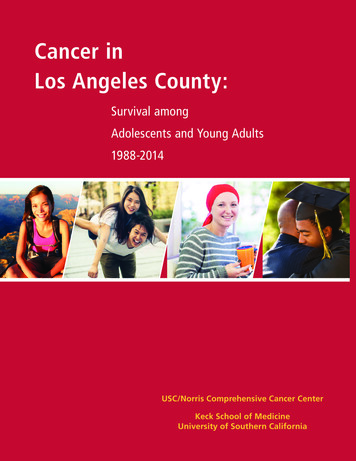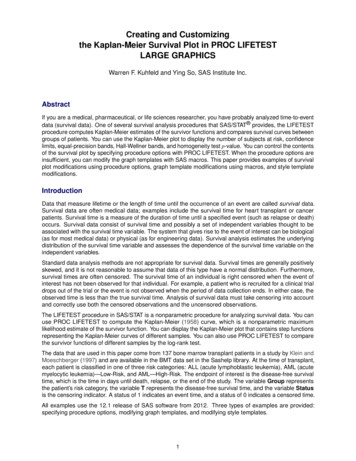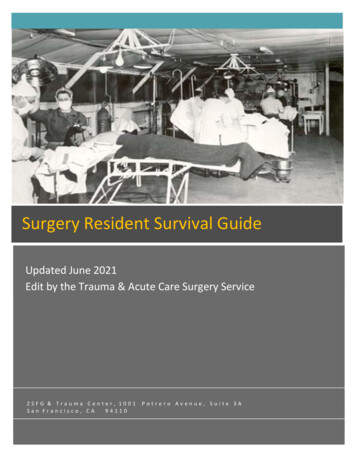
Transcription
Surgery Resident Survival GuideUpdated June 2021Edit by the Trauma & Acute Care Surgery ServiceZSFG & Trauma Center, 1001San Francisco, CA94110Potrero Avenue, Suite 3A
The Resident Survival Guide to Trauma & Acute Care SurgeryDoor Codes, Phones, and Pagers:3A: Door Code 5757 7A Resident Area: 7418* 7A36 INTERN/R2 Shared workroom: 20012nd-floor resident room: 35131 3M Clinic Door: 8201ZSFG phones: Dial 6, then the 4-digit number of the unit you're trying to reachZSFG pagers: Dial 61877, then enter the 4-digit pager number UCSF pagers: Dial 9 then 415-443- .NEW HOSPITAL PHONE AREA CODE: 628Intern Locker #67 in Building 25, B-level – 14-28-06Intern Locker #48 in Building 25, B-level – 06-28-18Intern Locker #49 in Building 25, B-level – 26-00-307A open computer workspace: This area is a QUIET ZONE! If you are taking a number of phone calls, pleaserelocate to the R2 Shared office space. Please be mindful of limiting noise during business hours. We WILLstill perform sign-out in this area in the AM & PM. COVID MEASURES Masks on in general areas please;Maintain social distancing.IntroductionWelcome to Trauma Surgery at the ZSFG! This guide is intended to orient you to the basics of how therotation works, expectations for interns, responsibilities on days versus nights, and provide some basics onhow to survive what can be a very busy month.Communication:We want you to communicate with us a lot. Text messages are fine for many things, but when we arescrubbed in the OR or do not respond quickly, please page us (If in the OR, just come into the OR to discussissues in-person). DO NOT communicate HIPPA information via text message. Text messages are not securemethods of communicating. Assume if we did not reply to your text message, we did not receive it.Information about a change in patient status should be communicated early. We don't want to be surprisedon AM rounds or PM sign out that a patient has had a change that we were not aware of. Communicatequestions for ICU patients at night. They are complex patients and we don't expect you to understand eachnuance of caring for them at this point in the year, though we do expect you to try.As with all information you present to us, we rely on you to be accurate. If you do not know something forsure, please just say you don't know. It can be hard to admit you haven't followed up on something, but it ismuch better to do that then to present incorrect information, which we will use to make decisions aboutpatient care.
The Resident Survival Guide to Trauma & Acute Care SurgerySIGN INTO EPIC patient team when you FIRST log in so nursing and other staffcan EPIC CHAT NON-URGENT ISSUESThere are key similarities and differences between the inpatient and outpatient communication strategies that Iwant to highlight: Regardless of setting, if an urgent/immediate response is needed, then numeric paging or a phone call should beused.In the inpatient setting, Secure Chat within Epic is strongly encouraged for most communications. For this to besuccessful, providers need to sign into Epic.In the outpatient setting, Secure Chat can be used liberally within an individual service/department. However,Secure Chat should not be used regularly to communicate between services/departments. Secure Chat may beappropriate when an immediate action is needed; however, you must page/call if there is no answer after 10minutes. Secure chat should never be used for results notification. Note that Secure Chat messages linked to apatient are purged at 72 hours and are not part of the legal medical record.More communication tools can be leveraged in the outpatient setting such as Telephone encounters (available inthe medical chart) and staff messages (not visible in the medical chart) to discuss non-urgent patient care issues.Trust the system: Epic results routing to the authorizing provider is robust, has flags that identify abnormal results,and is easily seen by cross-covering providersWe are all here to help you, and share the goal of taking excellent care of our patients. Youare an essential part of providing that care. Please let us know if anything is not clear.
The Resident Survival Guide to Trauma & Acute Care SurgeryThe TeamsCurrently, the Trauma ACS Service comprises four teams: Trauma A, B, C & D (Elective Surgery/Flex). Duringday shifts, you'll cover either Trauma C or D, while the NPs cover Trauma A & B and the ICU patients. Onnight shifts, you'll cover Trauma A & D (including ICU patients), or Trauma B & C (including ICU patients).There is always a SURGERY R4 or R5 in house (24 hours), an R2 who responds to all traumas and consults, aswell, during the day there isan R3 who attends surgical theater and/or helps out with traumas and consults.Team D INTERN Rounding Responsibilities: Weekdayso AM: 6AM: Rounds with R5 on Elective General Surgery Patientsprior to morning report 6:45 AM: Attends morning report with R5 & R3 Post Morning report:o Attend 2 3M Clinics per week (Mon / Fri)o Attend OR 2 days per week (Tues / Thur) Responsible for Clinical management of Team Dpatientso Attend Educational conferences on Wednesdays Clinical Coverage of Team D during educationalconference by NP / Chief Residento PM: Checks in with Senior Trauma Resident: to be assigned additionalafternoon duties pending Trauma/ACS service needs and needs ofthe Team D patientso 12:30 Clinic Dayso 2 pm OR dayso Wednesdays: after completion of educationalconferences Assigned duties may include: Assistance to Team A/B/C or ICU NP withacute inpatient care tasks. Assistance to R2 with trauma resuscitation /consultationWeekendso Attends resident sign out & morning reporto Rounds with Senior resident on Elective General Surgery Patients andselect Vascular Patients during Trauma / ACS rounds Vascular ICU Patients: Will be given time to round on prior to startof ACS ICU Rounds General Surgery ICU Patients: Will be rounded on by Trauma/ACSFaculty Elective General Surgery & Vascular Floor Patients: SeniorResident / Intern allowed to round on patients during Trauma/ACSRoundso Assists with service needs at the discretion of the Senior TraumaResident
The Resident Survival Guide to Trauma & Acute Care SurgeryTraumas (See Attached for Trauma Activation Criteria)Your pager will alert you when a trauma comes in. You will respond to the SHOCK TRAUMA & 900 (Major Activations)Trauma activations for the learning opportunity during the day. You should make yourself available during the day for900s, but these rooms are crowded and the aim is to have only the mid-level, the senior and the attending at the patientbedside.Night-time hours you will play more of an active role in the resuscitation (RE: Accurate Documentation,assisting as directed by the Senior Resident/Attending Surgeon). A 911 is a trauma where the initial reportsuggests the patient is hemodynamically stable. It is helpful to respond to multiple 911 Activations to assistwith patient care flow in the emergency department.The ScheduleINTERN Days: START (7A WARD, BUILDING 5) at 6am on weekdays, 6:30am on weekends or holidays. The entire team including the R4/R5, Fellow, & Attending meet in 3A at 6:45am on weekdays (Wed630A) and 7am on weekends/holidays to do formal morning report. The night interns are expected tosign out their Trauma & Acute Care Surgery patients to the oncoming Interns/NP prior to morningreport. The morning report is both for communication & education purposes. Pay attention and stayengaged!NEW ROOM FOR AM ROUNDS: (HG904), it should accommodate our whole team in person, but we will alsobe holding the Zoom meeting for those that prefer it.Directions: From 7A Bld 5: Take elevators to the ground floor. Head towards the main hospital, Bld 25. Afterpassing the blood bank, the conference room is the second door on the left-hand side of hallway.From Main Hospital Bld 25: Take elevators to the ground floor. Head towards Bld 5. Look for the scrubmachine sign on the right-hand side of hallway, the conference room is the first door on the right after thescrub sign. Morning rounds are targeted to be complete by 10 am. You should grab breakfast before hand. Yourday finishes at 5:45pm (SHARP) in 7A for ONE-ONE ward sign-out then Group ICU sign-out (R4 bunker)until approximately 6:30pm.NOTE: TUESDAYS you will arrive at 4:45pm prior to Journal Club Conference/M&M for Wardsign-out. ICU sign-out will occur after Journal Club Conference/M&M
The Resident Survival Guide to Trauma & Acute Care SurgeryGrand Rounds/ Teaching/ Skills Lab WEDNESDAYS:Wednesdays AM GRAND ROUNDS for general surgery on ZOOM. Attend your teaching and skills lab (ifassigned that day) & immediately after and head to the OR for your late morning/afternoon case (ONLY theresidents who have Skills Labs will return between 1130am & 12pm). You will still arrive for AM sign-out &one of the NPs with cross-cover your Trauma Ward team until you return.INTERN Nights: START (7A WARD, BUILDING 5) at 5:45pm where you'll receive sign-out from the day WARD internsand NPs (Trauma A&D combined and Trauma B&C combined). ICU SIGNOUT will be in the R4/R5 BUNKER with the OFF going NP from 6PM – 630PM. This is anopportunity for you to ask questions regarding complex patients THEN review a plan for the night withthe R4/R5. Your night ends at 6am (or 6:30am weekends/holidays) when you'll meet the day interns/NPs in 7Amain area and sign-out. You then stay for the beginning of morning report or new patients andteaching. Interns covering at night are expected to see all of their patients (trauma and acute care surgery) atleast once in the night/morning. You are expected to update the list with overnight events and newpatients by sign out time in the morning. We will usually request a list by 5:30. We expect updates tobe done by then and that all new patients will be on the list. All attendings, medication lists, labs,microbiology, abx, and surgeries should be checked when you update the list each day. With alarge service we rely on the list. Please include the last imaging dates/findings if there is space in thediagnosis space.ICU Notes should be prepared, SIGNED & assigned to the oncoming ATTENDING Surgeon.(Physical exams, Updated EPIC populated notes).The workflow of nights:1)2)3)4)Receive sign-outSwing through the ICU to enter orders, check in on patientsEnter orders for floor patients/round on floor patientsCheck in on ICU patients around midnight; record new labs, I/O’s, interval events, and report to yoursenior5) Complete rounding and ICU Progress Notes - sign and assign to oncoming Attending by 630AMPRINT HANDOFFS with CENSUS SHEET: ALL X3, ICU X1, Tra A, B, C, D X1 each
The Resident Survival Guide to Trauma & Acute Care SurgeryOTHER Members of the TRAUMA & ACUTE CARE SURGERY TEAM:SOCIAL WORKERS: We have TWO social workers covering all four Tr. Service Lines. You will speak with them in person and EPICCHAT group on patients.EPIC INPATIENT ORDERS Consult for Social Services with intake reasonUTILIZATION MANAGEMENT RNs: There will be one assigned to each service line. They will join the MSW on the call to discusspatients (What is keeping a patient in the hospital, anticipated DC, DC Needs Home VS SNF for example). UM RNs help withplacement of pts with referrals and home health referrals once placed. There is NO EPIC order to be placed for their involvement.PATIENT NAVIGATOR: Alex McConnell-Hill is our Pt Navigator who supports our workflow with obtaining Primary Care Follow-upappt; Off-service appointments; Disability paperwork; Patient/Family letters; Follow up phone calls to patients. Some appointmentsare not given at the time of DC from hospital, Alex contacts patients at home. NO EPIC order needed.PHYSICAL & OCCUPATION THERAPY: We have one of each assigned to our service each month (they rotate). Typical referralsinclude injured patient's needing a recovery treatment plan, including HOME versus FACILITY for REHAB. No every patient needs areferral they have mobilized on their own with deficits. Some medical causes for trauma such as syncope is helpful to evaluate forcoordination safety. PRO TIP: Make sure any weight bearing limitations are updated in the orders AND Bedrest is discontinued inActivity (if Appropriate).EPIC INPATIENT ORDERS Consult PHYSCIAL THERAPY /- OCCUPATIONAL THERAPYSPEECH & COGNITIVE THERAPY: We typically consult SPEECH when there is a question of dysphagia/risk of aspiration. Inaddition, we consult for persons with TBIs with related deficits (ST Memory, high level cognitive functioning deficits). So importantas baseline and follow with a TBI recovery.EPIC INPATIENT ORDERS: Consult SPEECH & COGNITIVE THERAPY complete the data collection screen.PICC LINE (VASCULAR ACCESS SERVICE): For TPN or longer term ABx we will obtain PICC typically.Two step process: INPATIENT Orders CONSULT PICC Service & complete the order collection screen - Then Page thePICC Team 327-4945 to alert them to the order and urgency so they can prioritize.
The Resident Survival Guide to Trauma & Acute Care SurgeryNotes Workflow:ALL Admissions must have an INITIAL ENCOUNTER .TRAUMAHPNEWICU Pts: EPIC: .TRAUMASICUPROGRESSNOTEWARD Pts: EPIC Daily Progress note unless Lower Level of Care (LLOC) ONLY THURS rounding.EPIC: PRGRESSNOTEMAY2021Post op Check .POSTOPCHECK2021If injury patient recent admission, then start a Trauma Tertiary Survey (TTS) in lieu of daily progress note.NOTE: TTS MUST BE COMPLETED WITHIN 36 hours of ADMISSIONEPIC: .TERTIARYTRAUMAIPVSCREENDischarge/Transfer Summary: Doubles as progress note for the day of transfer from our service. If short stay may use as a TTS aswell (Place a NOTATION “This services as the TTS”)EPIC: .TRAUMATTSDISCHARGEProcedure Notes: .CHESTUBEREMOVAL .DRAINREMOVAL .TRACHEOSTOMYDOWNSIZE.DECANNULATIONPROCEDURE .ASPLENICVACCINESCHEDULEAdvanced Care Planning Note: .ACPTQIP PC Surrogate & ACP Information: .TQIPSURROGATESurrogate Decision Maker: .TQIPSURROGATE2Goals of Care: .goalsofcareIncidental Findings: .incidentalfindingsCheck Daily HAND-OFF FACE Page for updated dot phrasesfor use. You have ALL been assigned the dot phrases.PRO TIPSEmergency Department Admitted Pts awaiting BedNOTE EPIC Admitted pts boarding in ED form order time to 8 hours will only have Antibiotics, Anticoagulation & Pain Meds initiated. If you need other orders write them as ONE TIME or STAT dependingon urgency and discuss with RN
The Resident Survival Guide to Trauma & Acute Care SurgeryTRAUMA TERTIARY SURVEY (TTS)TTS is to be performed once the final reads of radiological imaging are available within 24 to 36 hours ofpresentation. The completed Initial Encounter Note information will carry forward into the TTS note.The TTS must address spinal clearance (C-spine, and/or T L spine) for all patients not admitted to a spineservice (a medicine should not have to call a separate spine consult to get the 80-year-old syncopal womanout of a C-collar).Please coordinate all recommended trauma consults when appropriate and continue to follow (on the consultlist) any TTS with ongoing injury discovery or whose 'other' injuries are not fully attended to.Please watch the TTS lecture: https://www.youtube.com/watch?v oxIC6unoAwcThe R2/R3 is responsible for ALL TTS on injured patients admitted to another service in the hospital. (Hint: themost commonly 'missed injuries' in trauma are orthopedic and axial spine).Trauma Tertiary Survey (TTS) CHECKLIST:o Complete full Head to Toe Examination (See Below)o Obtain complete medical history and current medication list including look in CURESo Review all final reads of radiologic studies completed (Note any additions or corrections or INCIDENTALFINDINDGS to wet reads)o Order any imaging/testing for new suspected injurieso Call any consults needed for injury dispositiono Address disposition of C Spine & T/L Spine and document mechanism used to clear (Nexus, radiologic imagingetc); clear if able or document why unable with recommendations- eg pain on exam despite normal imagingo Compile Injury List and PLAN for injury careo List and address all current medical issues with relevant plan of care for each (eg when to resume meds safely)o LIST all INCIDENTAL FINDINGS with follow up recommendations for PCPNOTE: EPIC DOT PHRASE .TERTIARYTRAUMANORMAL PHYSICAL EXAM COMPONENTS FOR TTSNEURO: Alert & Oriented X3 Cranial nerves II – XII intact Moves all ext. strength symmetrical, no sensory deficitsHead: No lacerations or abrasions; No bony step offs ; Midface stable to palpation.Eyes: PERRL Conjunctiva/corneas without lesions EOM intact.Ears: Canals without blood or CSF drainage TMs clear External ears without lacerations.Nose: Septum midline No crepitus with motion.Throat: Oral mucosa without lacerations Teeth in place Tongue without lacerations.NECK: No midline pain with palpation No pain with active ROM No lacerations / wounds Trachea midline No JVD.RESPIRATORY: No crepitus No TTPEqual excursionNo abrasions/contusionsLungs: Breath sounds clear & symmetricalNo wheezes or ralesCARDIOVASCULAR: Heart rhythm regular rate S1S2 No R/M/GABDOMEN: Appearance: Non-distended no scar/ lacerations Palpation: Non-tenderness or peritoneal signs, no masses/organomegaly.PELVIC / PERINEAL: Normal male / female genitalia pelvis No TTP on Palpation or Leg liftBACK / SPINE: Thoracolumbar spinal column non-tenderno step off or deformityno blood noted at urethra meatus. Rectal exam: ( ) tone (-) for blood Male: normal riding prostateno external injury notedEXTREMITIES: Checking normal box means all joints are freely mobile & without pain, No lacerations, abrasions or swelling. IV sites are clean without erythema. Document pulse exam & ABI if penetratininjury to limb (or vasc compromise)
The Resident Survival Guide to Trauma & Acute Care Surgery
The Resident Survival Guide to Trauma & Acute Care SurgeryPatient Disposition: Start discharge planning earlyWork with social work to arrange for respite bed, SNF beds and rehab. Please keep your senior residentinformed if there are things preventing discharge, and be sure that each sign out includes information to yourco-interns about the status of discharge planning.Appointments: Every patient should have post hospitalization follow up with PCP: If new PCP is needed forSF City & Co residents then call 415-364-7942; If Kaiser UM care coordinator will arrange. If other privateinsurance then call provider directly and fax records. POST OP patients are allowed ONE clinic visit in 3M forfollow up as part of global fee. Follow up appointments usually fall between 1 and 3 weeks after dischargewith the surgeon or attending in charge of their care. Please be sure to check with the senior resident aboutwhen a patient should be seen in follow up.We have a PATIENT NAVIGATOR (Alex McConnell-Hill) Mon -Fri to assist with theappointments and returnauthorizations if needed.Be sure that any referral for follow up with the patient's primary MD or other specialist (cardiology, renaletc) are submitted and that the patient knows about the appointment and how to contact the clinic ifneeded.Making a 3M appt request in (Epic-Confirmed to be working)Go to your EPIC IN BASKET1.2.3.4.5.Click on NEW MESSAGEClick on the TO: buttonUnder the POOL search option type 3MChoose 3M FRONT DESK, JENNIFER MASSETTI & DIEMTHANH DOIn the notes section leave your appt request (Ex. Post op follow up 2 weeks. s/p OR for lap appy. Ifquestions call: LEAVE CALL BACK NUMBER in case they need to ask you a question about theappointment.)6. NOTE: Routine LAP APPYS & LAP CHOLE will have a telehealth follow upAPPOINTMENTS will be triaged after chart review & Patient Contacted on CURRENTMobile number (Make sure it is updated in EPIC)
The Resident Survival Guide to Trauma & Acute Care SurgeryMedications:Trauma Pharmacists are on service M-Fr 6A – 3P. They are fantastic about looking up "active medications" onpatients for admissions, medication updates (weight based, DVT prophylaxis etc) while inpatient & outpatientteaching prior to discharge. If patient’s require TPN, they will complete based on labs etc and PEND it in theORDERS for you to sign.Addiction Care Team: The team consists of an Attending, /- Fellow, Social worker, Pt Navigator for peoplewith substance use addictions (including alcohol). CO-manage withdrawal and offer enrollment in outpttreatment / long term management.Anesthesia Pain Service: Contacted for epidural insertion for pain control from injury or acute care surgery(RE: Rib fractures not responsive to PO/IV regimens, Complex ABD surgeries with NPO status etc). They thenmanage their acute pain meds until the Epidural is DC. They will also work with Addiction Care Team whenapprop. NOTE: DVT prophylaxis is Enox 40mg Bedtime for all patients with an epidural cath NORMAL renalfunction OTHERWISE Heparin SQ 5000 units BID (Hold AM dose day of insertion or removal).OVERALL, we FOCUS on multi-modal pain control to reduce unnecessaryopioid use for patients. ASK questions about pain control for yourpatients! This is important LEARNING!!!!(Example: Routine post-operative lap appy & lap chole patients shouldnot be going home on narcotics).Think about:- Preoperative medications - Have all home medications been restarted & is that appropriate? Is there a planfor when to restart them?- Will the patient need to see their primary MD about medication changes or new medical problems diagnosedin the hospital? (See Above)- Does the patient need anticoagulation as an Outpt? Are the correct teaching and appointments done?- Have you weaned Narcotics to "as needed". Limit the script for 5 days until PCP FUOpioid (controlled medications): Interns & Junior residents should get aControlled paper script from the R4/R5/Fellow or Attending (the day before ormorning of DISCHARGE to submit to Pharmacy). The NPs can ONLY perform thisduty if the Senior Staff are all occupied in OR (as an EMERGENCY back-up)MOST instances we can ONLY dispense a 10-day supply of medications at time ofdischarge unless we can justify/get approval Trauma Pharmacists can assistduring the weekdays.
The Resident Survival Guide to Trauma & Acute Care SurgeryWound care:WOUND RN CNS is Ossie on the 4th floor. We refer COMPLEX, long-term wounds & OSTOMY care to her. She issuper helpful for any wound care questions you have.- Inpatient "real-time" wound care resources are the R4/R5, Fellow, Attending & NP.- Has the patient received wound care instructions/ teaching? Have the family members received theinstructions/teaching?Preparing for Discharge:- Will they need a 4C clinic appointment for wound care before they are seen in the 3M clinic VS PCP?Discharge Pathway to DC orders to CLINIC WOUND CAREOrder set then be specific in request. You can either callover to the 4C clinic after you have submitted the Req(#63719) OR walk over to 4C (Building 5) to confirm anapprop APPT Date /Time.OUTPATIENT INFUSION CENTER ORDERS:
The Resident Survival Guide to Trauma & Acute Care SurgeryThese are not common on the service. Infusions can either be done with a home health order (SeeNext Section) OR 4C Infusion center order (See below) in the DISCHARGE NAVIGATOR. Once you havePLACED the 4C INFUSION REQUEST (Let the Trauma Pharmacist know) they can assist in the logistics- HOME HEALTH: Will they need a nurse to come to their home and help with wound care?Use the UNIT Navigator to DISCHARGE. Follow DC Orders (previous page) and TYPE in HOME HEALTH. An orderset willpop up. You will need to use this for home wound acre, PT, OT Speech therapy, Social work and home health aide.You can complete this days before DC if this is KNOWN. The social worker can help you is this is approp or not ANDtiming of request.
The Resident Survival Guide to Trauma & Acute Care SurgeryRESPITE REFERRALS: This provides a temporary residence to recover from injury & illness. The health staffassist with wound care and medication dispensing.DISCHARGE Navigator to the DC Order SETS (as on previous DC Examples). ENTER RESPITE. An e-consult order setwill be generated to complete. The Medical Respite intake will contact you. AT THE SAME TIME when you place theorder, also put an inpatient order in for: TB Skin Test (PPD); COVID PCR if not within 7 days surviellence & HEP AVaccine if never received. AS Flu Season approaches, a FLU VACCINE.
The Resident Survival Guide to Trauma & Acute Care SurgeryDrains/tubes:- Will the patient be going home with a JP, foley, or other drain? Have they gotten teaching to care for thatdrain?If the patient isn’t independent with existing drains then we typically submit a HOME HEALTH REFERRAL for the RN toreinforce teaching and monitor. See previous HOME HEALTH ordering instructionsStaples and sutures:- Does the patient have stitches or staples? Should they be removed before discharge?Nutrition:- Is the patient on a regular diet or a new special diet? Did you give them verbal instructions about the diet?- Will they need a feeding pump for tube feeds?Nutrition will assist with the logistics. This will NEED pre-authorization via UM RN and they will complete thepaperwork and submit it for approval.Repeat imaging:- Will the patients need another CT or MRI or x-ray before to their clinic appointment? Will they need a tubecheck for an IR drain?DISCHARGE NAVIGATOR orders section: Enter the specific study request along with the timeframe. They will contact thepatient at home. IR TUBE CHECKS will need and OUTPT e-CONSULT IR & contact the department to let them knowabout the DC home and they will follow the “tubes and drains” they placed.DISCHARGE INSTRUCTIONS for AFTER VISIT SUMMARY (AVS) (DISCHARGE NAVIGATOR)We are in the process of developing dot phrases for DC instructions. Some of you may already have standard information forcommon surgeries (RE: Appendectomy). Below is the GENERAL DC TO HOME data collection field that populates the AVS &provides RN instructions for DC Communicating DC meds in PHARMACY, DC PIV etc. NOTE: if you have used a dot-phrase inthe SPECIAL INSTRUCTIONS then you may just note that under HOSPITAL COURSE “Refer to Special Instructions”
The Resident Survival Guide to Trauma & Acute Care SurgeryZSFG 4A SNF TRANSFERS: Patients are ready for transfer at 9AM for the assigned day. The below should be prepared48 hours prior to transfer to 4A SNF. SCREENING FOR ACTIVE TUBERCULOSISoooo Place PPD (or obtain CXR if known positive) (EPIC ORDER Bedside RN will place)If known neg PPD within past 6 months, document date and result -- no need to repeat and no need forx-rayCXR if PPD positive or PPD not yet ready to interpret at transfer or patient declines PPDwe will also accept NEG quantiferon within the past six months if that is availableCOVID SURVEILLANCEo Negative coronavirus test within 2 days of transfer to 4A. No exceptionsInfluenza vaccine (or document allergy or date patient declines vaccine)Providers complete discharge readmit pathwayooo use the correct navigator in order to ensure all orders are carried through safely and correctlyindications must be listed for EACH medication to be continued on 4A.behavior to monitor, in addition to indication, must be listed under admin instructions for ALLpsychotropic medications, including melatonin (Ex: melatonin 3 mg po at bedtime indication is insomniabehavior to monitor is unable to fall asleep).o use the SNF admission orderseto complete discharge summary prior to transfer to 4APlace any outpatient referrals and schedule all necessary follow-up related to this hospitalizationINTER-FACILITY TRANSFERS (OFF CAMPUS) (SNF, Acute Rehab & Acute Care Hospitals): Out of networkpatients: typically, patients will be repatriated to their home network if they have continued acute care needs. If rehabneeds exist, then SNF rehab VS Acute rehab may be possibilities. Once those decisions are made and SOCIAL WORK &UM are notified perform the following:ACUTE CARE HOSPITAL TRANSFER: (GO TO DISCHARGE NAVIGATOR) Review/confirm Problem list & Cosign Orders Enter any Special Instructions (Otherwise the AVS – After Visit Summary isn't required) Open DISCHARGE Summary (serves as the TRANSFER SUMMARY) and complete. (Sign if "day of" Transfer). Add theinpatient med list use .meds (scheduled and PRN) to add to your summary (UM will coordinate Provider-Provider signout) Reconcile MEDICATION List in DISCHARGE ORDERS. For all CONTINUING meds make sure each med has "NO PRINT" (sooutpatient pharmacy won't dispense). When you have an Ambulance pick-up time, write the final DC Order.SNF REHAB OR ACUTE REHAB TRANSFERS: (GO TO DISCHARGE NAVIGATOR) Review/confirm Problem list & Cosign Orders Enter any Special Instructions & complete the AVS (After Visit Summary) along with reconciled medications. NOTE: SomeSNF Rehabs will need 48 hours of OPIOIDS Get that PAPER SAFE SCRIPT from R4/R5 in AM. Otherwise, confirm is othermeds need to be dispensed. If not, then "NO PRINT" (so outpatient pharmacy won't dispense). FOR SNF TRANSFERS: Some facilities require ADMIT ORDERS are written. These are paper orders found in 7A (SNFAdmission orders, PT/OT Speech Rehab orders) place in chart and alert SOCIAL WORK to fax to facility. Medications will betaken from the DC SUMMARY
The Resident Survival Guide to Trauma & Acute Care Surgery Open DISCHARGE Summary (serves as the TRANSFER SUMMARY) and complete & SIGN to fax to facility then Provider toProvider sign -outJUNIOR RESIDENT:Trauma Injury (SHOCK TRAUMA, 900, 911 & Non-Trauma Activations) & Acute Care Surgery Consults:All consults use the appropriate H&P (Trauma OR ACS) in EPIC. Making sure that this NOTE is filled outcompletely and accurately (preliminary reads of all radiological imaging, documentation of all consults alreadycalled, lab results, FAST results and a detailed clinical examination) is essential. Documentation of limbmovement, specific pulse quality & results of rectal exam are often overlooked (especi
The Resident Survival Guide to Trauma & Acute Care Surgery Door Codes, Phones, and Pagers: 3A: Door Code 5757 7A Resident Area: 7418* 7A36 INTERN/R2 Shared workroom: 2001 2nd-floor resident room: 35131 3M Clinic Door: 8201 ZSFG phones: Dial 6, then the 4-digit number of the unit you're trying to reach

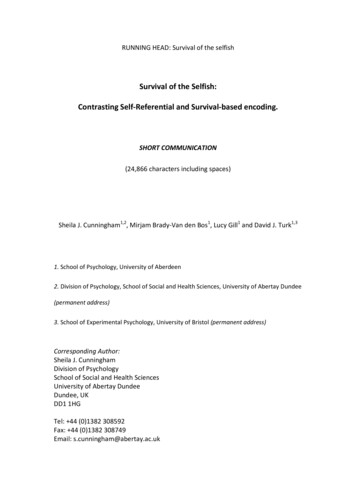




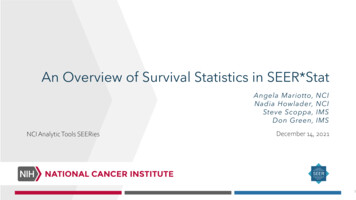

![[ST] Survival Analysis - Stata](/img/33/st.jpg)
